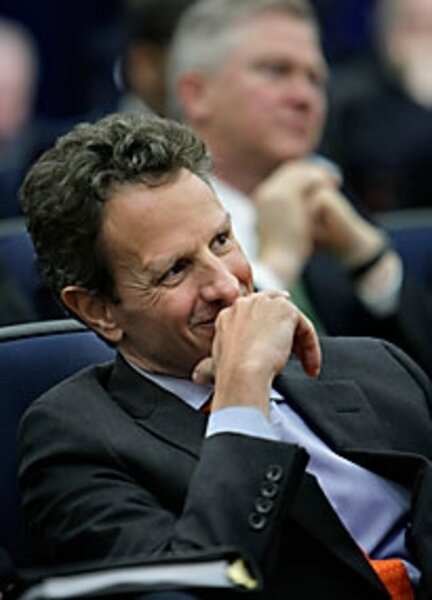What's behind mixed signals from Obama and Geithner on TARP?
Loading...
President Obama said Tuesday that the TARP bailout program has served its purpose and is being wound down. Treasury Secretary Timothy Geithner sent a different signal Wednesday, with the gist of his message being this: Not any time soon.
In a letter to Congress, Mr. Geithner said he is authorizing the Troubled Asset Relief Program (TARP) to continue through Oct. 3 next year, and that as much as $550 billion of the $700 in potential funds could be deployed. So the TARP, after having served its purpose over the past year, is going to keep on serving.
What do these seemingly mixed signals mean? They're a sign of how the politically-unpopular TARP remains a hot potato – something Washington wants to get rid of but can't. The financial system is still too shaky for the emergency support to be pulled away, though the rescues are proving less costly than expected, experts say.
An independent panel waded into these complicated issues with its own report Wednesday. The Congressional Oversight Panel, headed by Elizabeth Warren, came to some pointed but nuanced conclusions: The TARP, along with other strong government actions, "can be credited with stopping an economic panic," but big problems in the financial system remain, the report said.
The maneuvering over TARP comes at an important moment for three reasons:
• The economy is trying to emerge from recession, and the strength of the rebound depends in part on how the TARP program is managed.
• The Obama administration and Congress are making the case that TARP "savings" – as the program comes in with lower-than-expected costs – free up about $200 billion that could be spent for a jobs program.
• Congress is considering regulatory reform of the financial sector, and much of the effort boils down to the fundamental question of how to avoid TARP-style bailouts in the future.
The president and his Treasury secretary weren't quite talking past each other in their statements this week. Mr. Obama didn't say the program would end immediately but would "wind down" since the program "has served its original purpose." And Geithner framed his extension of the program as an "exit strategy."
Still, the Treasury's move to maintain the program into next year is a reminder that the financial bailouts are still unfinished, and that uncertainties remain. Some banks have repaid TARP funds, while others have been unable to even pay the dividends they owe to taxpayers on Treasury money invested. In addition, the bailout funds are being used to support automakers, the insurer AIG, and the mortgage giants Fannie Mae and Freddie Mac.
The fact that firms such as Bank of America have been able to repay the TARP money is a good sign. It means that many banks are able to raise capital from private investors. With help from low Federal Reserve borrowing costs, many banks are earning enough money to cover losses on mortgage and other loan defaults.
And the repayment trend has led the Treasury to dial down its estimates of what TARP will cost taxpayers, by about $200 billion. In his letter Wednesday, Geithner told congressional leaders that he expects "up to $175 billion in repayments by the end of next year, and substantial additional repayments thereafter." Republicans argue that TARP repayments should be used to reduce federal deficits, not used for other spending.
Companies have a strong incentive to exit the TARP if they can, says Brian Bethune, an economist at IHS Global Insight in Lexington, Mass. In addition to getting out from government caps on pay for top executives – a condition of bailouts – paying back the Treasury may signal to investors that the firm is healthier than bailed-out rivals, he says.
But overall, the financial sector is hardly back to normal, despite the support from TARP and Federal Reserve over the past year.
"Not enough capital is being generated yet in overall banking system to get us back to a normal situation with the flow of credit," Mr. Bethune says.
The oversight panel headed by Ms. Warren reached similar conclusions. Banks remain reluctant to lend and have many "toxic assets" still on their books. Foreclosures continue to rise. And many firms or credit markets continue to rely on government support.
"It is unclear whether the market can yet withstand the removal of this support," the report said.
See also:
Obama jobs plan: big ideas, but a big hole to fill in hiring
Using TARP funds for job creation: creative or reckless?
Bernanke speech: financial stability is returning
---
Follow us on Twitter.





